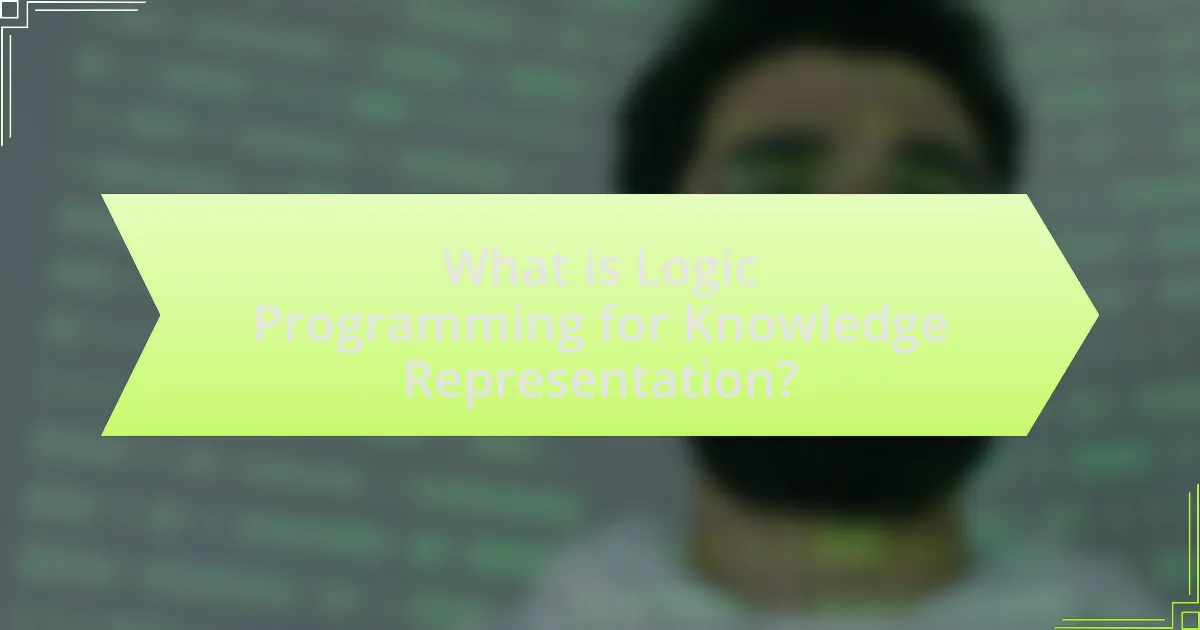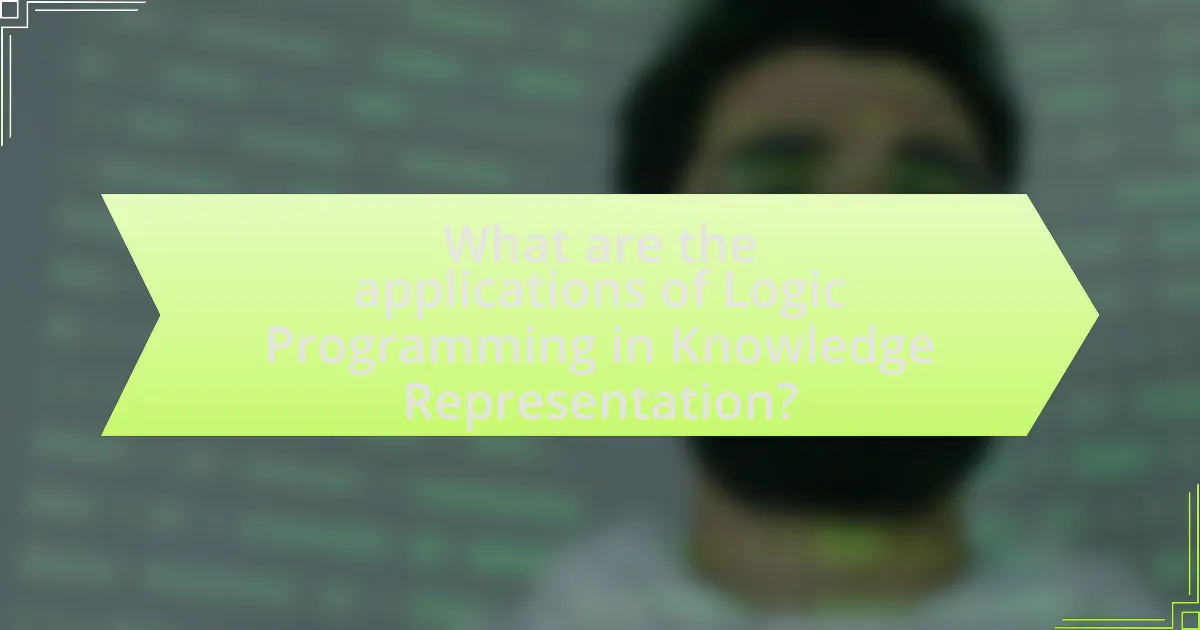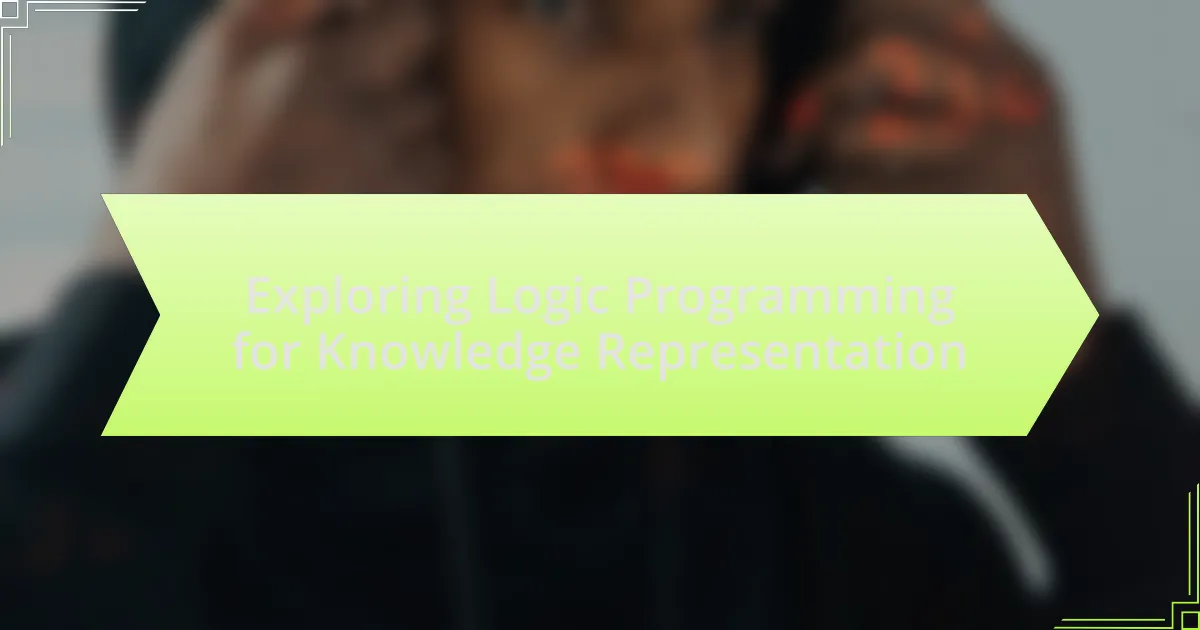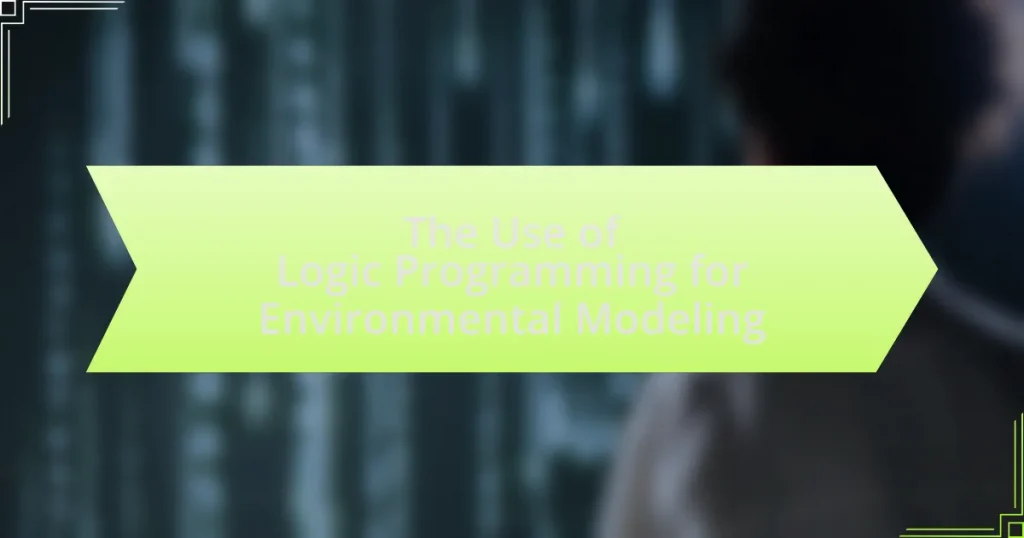Logic programming for knowledge representation is a formal paradigm that utilizes first-order logic to encode facts and rules, enabling automated reasoning systems to infer new information. This article explores the principles and advantages of logic programming, highlighting its role in artificial intelligence and database systems. Key components such as facts, rules, and queries are examined, along with the comparison of languages like Prolog and Datalog. Additionally, the article addresses the challenges faced in knowledge representation, including expressiveness and computational complexity, while offering best practices for effective implementation. The significance of logic programming in enhancing reasoning capabilities and supporting applications in natural language processing and expert systems is also discussed.

What is Logic Programming for Knowledge Representation?
Logic programming for knowledge representation is a paradigm that uses formal logic to represent and reason about knowledge. It enables the encoding of facts and rules in a way that allows automated reasoning systems to infer new information from existing knowledge. This approach is grounded in first-order logic, where statements can be expressed in a structured format, facilitating the development of intelligent systems capable of drawing conclusions based on the provided data. The effectiveness of logic programming in this context is evidenced by its application in various domains, such as artificial intelligence and database systems, where it supports complex queries and reasoning tasks.
How does Logic Programming facilitate Knowledge Representation?
Logic programming facilitates knowledge representation by using formal logic to express facts and rules about a domain. This approach allows for the clear and unambiguous representation of knowledge, enabling automated reasoning and inference. For instance, in Prolog, a popular logic programming language, knowledge is represented as a set of facts and rules, which can be queried to derive new information. The ability to use logical constructs such as predicates and quantifiers enhances the expressiveness of knowledge representation, making it suitable for complex domains like artificial intelligence and natural language processing.
What are the fundamental principles of Logic Programming?
The fundamental principles of Logic Programming include the use of formal logic as a programming paradigm, the representation of knowledge through facts and rules, and the execution of programs via a process of logical inference. Logic Programming is based on the idea that programs can be expressed as a set of logical statements, where the computation is performed by deriving conclusions from these statements using inference rules. This approach allows for declarative programming, where the focus is on what the program should accomplish rather than how to achieve it. The validity of these principles is supported by the success of languages like Prolog, which utilize these concepts to solve complex problems in artificial intelligence and knowledge representation.
How does Knowledge Representation differ from traditional programming?
Knowledge Representation differs from traditional programming primarily in its focus on how information is structured and utilized rather than on procedural instructions. Traditional programming emphasizes algorithms and control flow to execute tasks, while Knowledge Representation aims to model complex relationships and reasoning about information, enabling systems to infer new knowledge from existing data. For instance, in Knowledge Representation, ontologies and semantic networks are used to define concepts and their interrelations, allowing for more flexible and intelligent data manipulation compared to the rigid structures of conventional programming languages. This distinction is crucial in fields like artificial intelligence, where understanding and reasoning about knowledge is essential for tasks such as natural language processing and automated reasoning.
Why is Logic Programming important for Knowledge Representation?
Logic programming is important for knowledge representation because it provides a formal framework for expressing facts and rules about the world in a way that is both human-readable and machine-executable. This paradigm allows for the representation of complex relationships and reasoning processes through logical statements, enabling systems to infer new information from existing knowledge. For instance, Prolog, a well-known logic programming language, uses a declarative approach that facilitates the representation of knowledge in a structured manner, making it easier to implement automated reasoning and problem-solving capabilities. The ability to represent knowledge in this way is crucial for applications in artificial intelligence, where understanding and manipulating knowledge is fundamental to tasks such as natural language processing and expert systems.
What advantages does Logic Programming offer in representing knowledge?
Logic Programming offers several advantages in representing knowledge, primarily through its declarative nature, which allows for clear expression of facts and rules. This approach enables users to focus on what the knowledge is rather than how to compute it, facilitating easier understanding and manipulation of complex information. Additionally, Logic Programming supports automated reasoning, allowing systems to infer new knowledge from existing facts using logical rules, which enhances the efficiency of knowledge processing. Furthermore, its formal semantics provide a robust framework for ensuring consistency and correctness in knowledge representation, making it suitable for applications in artificial intelligence and database systems.
How does it enhance reasoning capabilities in artificial intelligence?
Logic programming enhances reasoning capabilities in artificial intelligence by providing a formal framework for representing knowledge and deriving conclusions through inference. This approach allows AI systems to utilize rules and facts to deduce new information, enabling them to solve complex problems and make decisions based on logical relationships. For instance, Prolog, a prominent logic programming language, employs a resolution-based inference mechanism that systematically applies logical rules to derive conclusions from given facts, demonstrating its effectiveness in tasks such as automated theorem proving and natural language processing.

What are the key components of Logic Programming?
The key components of Logic Programming are facts, rules, and queries. Facts represent basic assertions about the world, rules define relationships and infer new information from existing facts, and queries are used to retrieve information based on the defined facts and rules. For example, in Prolog, a popular logic programming language, a fact might state “socrates is a man,” while a rule could express “all men are mortal.” This structure allows for logical reasoning and problem-solving, making Logic Programming effective for knowledge representation.
What languages are commonly used in Logic Programming?
Prolog is the most commonly used language in Logic Programming. It is specifically designed for symbolic reasoning and has been widely adopted in artificial intelligence and computational linguistics. Other notable languages include Mercury, which emphasizes efficiency and strong typing, and Datalog, often used in database queries and knowledge representation. These languages are grounded in formal logic, allowing for the expression of facts and rules, which facilitates automated reasoning and problem-solving.
How do Prolog and Datalog compare in terms of features?
Prolog and Datalog differ significantly in their features, primarily in terms of expressiveness and use cases. Prolog supports complex data structures, procedural programming, and backtracking, allowing for more expressive queries and the ability to handle dynamic data. In contrast, Datalog is a subset of Prolog focused on declarative programming, emphasizing simplicity and efficiency in querying databases, particularly for recursive queries.
Prolog’s features include support for unification, which enables pattern matching, and the ability to define predicates with side effects, making it suitable for applications like natural language processing and AI. Datalog, however, is designed for rule-based querying and lacks the procedural constructs of Prolog, making it more efficient for database applications where performance is critical.
The differences in features are evident in their applications: Prolog is often used in AI and complex problem-solving scenarios, while Datalog excels in database management and reasoning tasks.
What role do rules and facts play in Logic Programming languages?
Rules and facts are fundamental components of Logic Programming languages, serving as the basis for knowledge representation and inference. Facts represent basic assertions about the world, while rules define relationships and logical implications between those facts, enabling the derivation of new information. For instance, in Prolog, a fact might state “Birds are animals,” and a rule could express “If something is a bird, then it can fly.” This structure allows Logic Programming languages to perform automated reasoning, where the system can infer conclusions based on the provided facts and rules. The effectiveness of this approach is evidenced by its application in artificial intelligence, where systems utilize rules and facts to solve complex problems and make decisions based on logical reasoning.
How do inference mechanisms work in Logic Programming?
Inference mechanisms in Logic Programming operate by applying rules of logic to derive conclusions from a set of premises or facts. These mechanisms utilize a formal system, typically based on first-order logic, where facts are represented as logical statements and rules dictate how new facts can be inferred from existing ones.
For example, the resolution principle is a common inference mechanism that involves refuting a negation of a conclusion by deriving a contradiction from a set of premises. This method systematically eliminates possibilities until a conclusion is reached, ensuring that the derived conclusions are logically valid based on the initial premises.
Additionally, forward chaining and backward chaining are two primary strategies used in inference. Forward chaining starts with known facts and applies rules to infer new facts until a goal is reached, while backward chaining begins with a goal and works backward to determine if the known facts support that goal. These strategies are foundational in systems like Prolog, which is widely used for knowledge representation and reasoning in artificial intelligence.
What are forward and backward chaining in inference?
Forward chaining is a data-driven inference method that starts with known facts and applies rules to derive new facts until a goal is reached. In contrast, backward chaining is a goal-driven approach that begins with a goal and works backward to determine which facts must be true to support that goal. Both methods are fundamental in logic programming and knowledge representation, as they facilitate automated reasoning by systematically applying logical rules to derive conclusions from a set of premises.
How do these mechanisms affect knowledge retrieval?
Mechanisms in logic programming significantly enhance knowledge retrieval by enabling structured representation and efficient querying of information. These mechanisms, such as rules and facts, allow for the organization of knowledge in a way that facilitates logical inference and retrieval processes. For instance, Prolog, a prominent logic programming language, utilizes a resolution-based approach that systematically searches through defined rules and facts to derive conclusions, thereby improving the accuracy and speed of knowledge retrieval. This structured approach is supported by the fact that logic programming can represent complex relationships and dependencies, making it easier to retrieve relevant information based on specific queries.

What are the applications of Logic Programming in Knowledge Representation?
Logic programming is applied in knowledge representation primarily through the use of formal languages like Prolog, which enable the encoding of facts and rules about a domain. This approach allows for the representation of complex relationships and reasoning about them, facilitating tasks such as automated theorem proving, natural language processing, and expert systems. For instance, Prolog’s inference engine can derive new information from existing knowledge, making it valuable in applications like medical diagnosis systems and legal reasoning frameworks, where logical deductions are essential for decision-making.
How is Logic Programming used in expert systems?
Logic programming is utilized in expert systems primarily for knowledge representation and reasoning. It allows for the formalization of knowledge in a way that can be easily processed by computers, using rules and facts to derive conclusions. For instance, Prolog, a prominent logic programming language, enables the encoding of domain-specific knowledge through logical statements, which can then be queried to infer new information or make decisions based on existing data. This capability is essential in expert systems, as it facilitates automated reasoning, allowing the system to simulate human expertise in various fields such as medical diagnosis or financial forecasting.
What are the benefits of using Logic Programming in decision-making processes?
Logic Programming enhances decision-making processes by providing a clear and structured way to represent knowledge and reason about it. This approach allows for the formulation of complex rules and relationships, enabling automated reasoning systems to derive conclusions from given facts. For instance, Prolog, a well-known logic programming language, facilitates the implementation of algorithms that can efficiently solve problems by searching through possible solutions based on logical inference. Additionally, the declarative nature of logic programming allows users to focus on what the problem is rather than how to solve it, which can lead to more intuitive and maintainable code. This structured representation and reasoning capability significantly improve the accuracy and efficiency of decision-making in various applications, such as expert systems and artificial intelligence.
How does it support natural language processing tasks?
Logic programming supports natural language processing tasks by providing a formal framework for representing and reasoning about knowledge. This framework allows for the creation of rules and facts that can be easily manipulated to understand and generate human language. For instance, Prolog, a prominent logic programming language, enables the development of parsers and interpreters that can analyze sentence structure and semantics, facilitating tasks such as machine translation and information retrieval. The effectiveness of logic programming in NLP is evidenced by its application in systems like chatbots and automated reasoning engines, which rely on logical inference to process and respond to user queries accurately.
What challenges exist in using Logic Programming for Knowledge Representation?
Logic Programming faces several challenges in Knowledge Representation, primarily related to expressiveness, computational complexity, and handling uncertainty. The expressiveness challenge arises because certain real-world knowledge cannot be easily represented in the formal syntax of logic programming languages, limiting their applicability. Computational complexity issues stem from the inherent difficulty in reasoning about knowledge bases, particularly as the size of the data grows, leading to increased processing time and resource consumption. Additionally, logic programming traditionally struggles with representing uncertain or probabilistic information, which is often necessary for modeling real-world scenarios. These challenges highlight the limitations of logic programming in effectively capturing and reasoning about complex knowledge domains.
What limitations do Logic Programming languages have?
Logic programming languages have several limitations, including difficulty in handling side effects and performance issues. These languages primarily focus on declarative programming, which can lead to inefficiencies when dealing with tasks that require mutable state or procedural operations. For instance, Prolog, a well-known logic programming language, struggles with tasks that involve extensive input/output operations or real-time processing, as it is not designed for such scenarios. Additionally, logic programming can face challenges in scalability, particularly when dealing with large datasets or complex queries, which can result in slower execution times compared to imperative programming languages.
How can these challenges be addressed in practical applications?
Challenges in logic programming for knowledge representation can be addressed through the development of robust frameworks and tools that enhance expressiveness and efficiency. For instance, integrating constraint logic programming can improve problem-solving capabilities by allowing for more complex relationships and conditions to be represented. Additionally, utilizing advanced reasoning algorithms, such as those based on answer set programming, can optimize the inference process, making it faster and more reliable. Empirical studies, such as those conducted by Gelfond and Lifschitz in their work on answer set semantics, demonstrate that these approaches can significantly enhance the practical applicability of logic programming in real-world scenarios.
What best practices should be followed when implementing Logic Programming for Knowledge Representation?
When implementing Logic Programming for Knowledge Representation, best practices include clearly defining the knowledge domain, using a modular approach, and ensuring consistency in representation. Clearly defining the knowledge domain helps in identifying relevant facts and rules, which enhances the accuracy of the representation. A modular approach allows for easier updates and maintenance of knowledge bases, facilitating scalability. Ensuring consistency in representation prevents contradictions and ambiguities, which is crucial for effective reasoning. These practices are supported by the principles of knowledge engineering, which emphasize clarity, modularity, and consistency as essential for robust knowledge representation systems.



